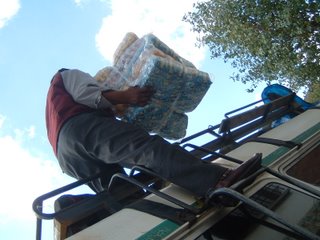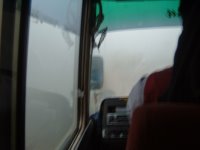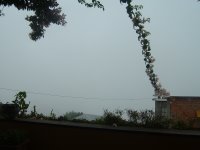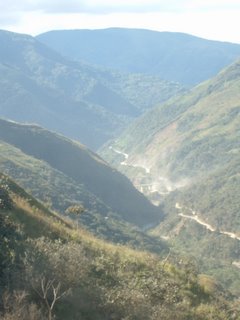I had just wrapped up a lovely conversation with a young French activist named Gregory, after a lovely souffle dinner and a chocolate and banana crepe for dessert, and retired to my room, settling down as comfortably as possible on the flattened "mattress" pad that provided only the slightest bit of cushion. Suddenly, I saw an ugly brown, 4 inch long monster with eight legs creeping up the opposite wall -- you know, the kind that doesn't spin a web to catch food; it hunts for food.
Naturally, I did what anyone else would do -- I screamed and threw on my shoes to run for help. Trust me, had you seen the whopper, this would have been your first instinct too. But then I thought the thing might crawl into my bag, so I shoved everything into my bag, zipped it, and then started to run for help. But the freakin' creature kept moving! Gripped with a sickening fear, I resigned myself to doing the deed. I mean, what if it disappeared under my pillow just as I found someone else to kill it and we couldn't find it and I'd have to die a slow, painful, spider-induced death in my sleep? That just wouldn't do. So, I tore off my boot and cautiously approached the intruder, all the while telling myself that I was a lot bigger than it. I think it understood what I was saying because the beast took off like a rocket. After a short chase, the ghastly brute tried to sneak behind a thatched wall hanging and I mercilessly smashed it through the decor -- once, twice, six times just to be on the safe side. Thus ended the Hunt for the Great Arachnid. It then took about 20 minutes and 736 glances around the room for my heart to stop racing. I hate spiders.
 So right. Back to the World's Most Dangerous Road. According to the Inter-American Development Bank, an average of 26 vehicles disappear over the edge. That's about one vehicle every 2 weeks. However, La Paz locals assured me that it was fine, as long as I don't travel at night. So, I merrily booked a seat on the 3pm minibus (which turned out to be a bigger, scarier microbus). As I watched the driver load up the cargo on top of the bus, a 70-something drunk Bolivian man named Miguel tried to befriend me and I quickly moved away. What is it with me and 70 year old Bolivian men?
So right. Back to the World's Most Dangerous Road. According to the Inter-American Development Bank, an average of 26 vehicles disappear over the edge. That's about one vehicle every 2 weeks. However, La Paz locals assured me that it was fine, as long as I don't travel at night. So, I merrily booked a seat on the 3pm minibus (which turned out to be a bigger, scarier microbus). As I watched the driver load up the cargo on top of the bus, a 70-something drunk Bolivian man named Miguel tried to befriend me and I quickly moved away. What is it with me and 70 year old Bolivian men?We finally boarded around 3:10 pm and guess who was sitting next to me? For the next three hours, Miguel imbibed what smelled like rubbing alcohol, blabbed about his 10 wives, sang love songs, and invited me to his house 18 times. Here are a few of the English equivalents of my side of the conversation: "Yeah." "Whatever." "Why do you think I'm going to do that?" "Who talks like this?" "Why are you touching my arm?" "I'm not sad, you just talk too much. Go away." I became rather rude by the end of the 3 hours.
And I learned that the only thing scarier than driving down the WMDR at night
 is driving in a fog (and co-habitating with giant arachnids). That's the driver you see over on the right. Notice how you can't really see anything out the window. Eventually, after 2 excruciating hours of blindly winding down a narrow, unpaved mountain road, the fog partially lifted and I caught a glimpse of purple mountains in the distance and big, green, leafy vegetation everywhere. Unfortunately, the view lasted about 20 minutes and it was nighttime. When I finally fell asleep around 2am (with the light on, hoping it would prevent other vermin of the night from emerging), I comforted myself with thoughts of the breathtaking view in the morning light.
is driving in a fog (and co-habitating with giant arachnids). That's the driver you see over on the right. Notice how you can't really see anything out the window. Eventually, after 2 excruciating hours of blindly winding down a narrow, unpaved mountain road, the fog partially lifted and I caught a glimpse of purple mountains in the distance and big, green, leafy vegetation everywhere. Unfortunately, the view lasted about 20 minutes and it was nighttime. When I finally fell asleep around 2am (with the light on, hoping it would prevent other vermin of the night from emerging), I comforted myself with thoughts of the breathtaking view in the morning light. After a restless sleep filled with coughs and sneezes (I've got a cold), I woke up in a fog. Literally. No view. Nothing. Just a lot of thick white fog that nestled itself into every possible crevice of the landscape and suffocated it. I walked to the center of town, keely aware of how out of place I looked into this itty bitty pueblo and chose a German spot for breakfast. Facing the white sheet that had been pulled over the land, I enjoyed the first decent cup of coffee I've had in a month, and chatted with a couple from Denmark. But as a bizarre mix of Bob Marley, opera, Eric Clapton, bad 80s electronica and samba tunes swung through the air, shy Coroico slowly parted her cottony curtain to reveal a lush, emerald green vista. I oohed and aahed diligently, snapped photos, and still came to the conclusion that I wou
After a restless sleep filled with coughs and sneezes (I've got a cold), I woke up in a fog. Literally. No view. Nothing. Just a lot of thick white fog that nestled itself into every possible crevice of the landscape and suffocated it. I walked to the center of town, keely aware of how out of place I looked into this itty bitty pueblo and chose a German spot for breakfast. Facing the white sheet that had been pulled over the land, I enjoyed the first decent cup of coffee I've had in a month, and chatted with a couple from Denmark. But as a bizarre mix of Bob Marley, opera, Eric Clapton, bad 80s electronica and samba tunes swung through the air, shy Coroico slowly parted her cottony curtain to reveal a lush, emerald green vista. I oohed and aahed diligently, snapped photos, and still came to the conclusion that I wou ld rather sleep in the spider-free comfort of Zona Sur in La Paz. I had just enough time to change my bus seat, walk around the center plaza, and chill out on the hostel's mountainside deck. Interestingly enough, I ran into yet another 70-something Bolivian man, who struck up a conversation with me during the uphill trek back to the hostel -- at least this one was nice. He'd worked on a merchant ship that brought goods back and forth from China, Japan, Hong Kong and Taiwan.
ld rather sleep in the spider-free comfort of Zona Sur in La Paz. I had just enough time to change my bus seat, walk around the center plaza, and chill out on the hostel's mountainside deck. Interestingly enough, I ran into yet another 70-something Bolivian man, who struck up a conversation with me during the uphill trek back to the hostel -- at least this one was nice. He'd worked on a merchant ship that brought goods back and forth from China, Japan, Hong Kong and Taiwan.The ride back to La Paz was wonderfully uneventful, although I bet the other passengers were quietly laughing at the Asian tourist who kept opening the window to take pictures. I've posted below some of the better pictures of Coroico and the ride back. As picturesque as it all is, I was glad to finally make it back to the place I've called home for the past month. Plus, cutting the Coroico trip short meant that I would have one more opportunity to see the boys I had to say goodbye to on Friday. More on that tearful goodbye later. I return to the States tomorrow, hardly able to believe that I've been in Bolivia for a month.



No comments:
Post a Comment